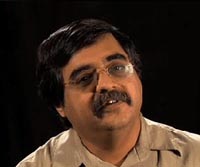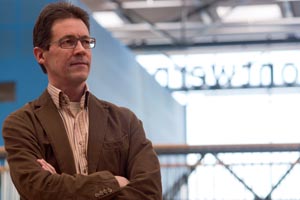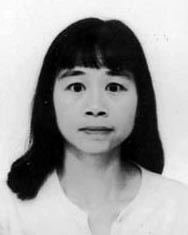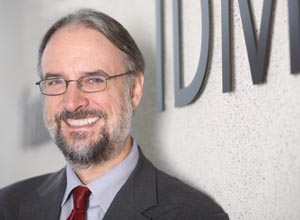Plenary Talks
Nasir Memon – Image and Video Forensics
Abstract
We find ourselves today in a "digital world" where most information is created, captured, transmitted, stored, and processed in digital form. Digital information permeates every aspect of our daily lives. Although representing information in digital form has many compelling technical and economic advantages, it has led to new issues and significant challenges when performing forensics analysis of digital evidence.
The last few years have seen much research in the young and emerging subjects of Image and Video Forensics. The topic is inherently multi-disciplinary involving computer science and engineering, signal processing, and criminal justice at the very least. This talk provides an overview of this emerging area and Nasir Memon is a Professor in the computer science department at the Polytechnic Institute of New York University, New York. He is the director of the Information Systems and Internet Security (ISIS) lab at Polytechnic (isis.poly.edu).
Biography
Prof. Nasir Memon got his BE in Chemical Engineering and MS in Math from BITS, Pilani, India, 1981. He got his MS in Computer Science (1989) and PhD in Computer Science (1992) from the University of Nebraska, Lincoln. Prof. Memon's research interests include Digital Forensics, Data Compression, Computer and Network Security and Multimedia
Computing and Security. He has published more than 250 articles in journals and conference proceedings and holds more than a dozen
patents in image compression and security. He has won the NSF CAREER award and the Jacobs Excellence in Education award. His
research has been featured in NBC nightly news, NY Times, MIT Review, Wired.Com, New Science Magazine, etc. |
|
Arnold Vermeeren & Effie Law – Good User Experience: Yes! But what is it?
Abstract
Wow! This interaction feels good! – Meeting those people at QoMEX was a real good experience! – It is such a good
experience always being able to go online and having my Apps available wherever I am, whenever I want! – It felt so good
having the new iPad2 before everybody else had it!
User experience (UX) is booming! UX is a buzzword: professionals, marketing specialists, researchers, and teachers have all
started using the term. The examples in the first lines refer to different ways of using the term. It can relate to how one feels
during an ongoing activity (Wow!), to reflective feelings after an activity (having met people at QoMEX), to even longer periods
in one's life, including periods of using and not using a product (wherever, whenever), or to just possessing a product (iPad2).
Moreover, UX is sometimes related to usability, to aesthetics, to social status, and the list is endless. There is no consensus on
the scope of UX. This hinders the development or choice of appropriate UX design methods and methods for evaluating UX quality.
In a series of scientific events and efforts we have aimed at developing a shared understanding, scoping and definition of UX from
theoretical and practical perspectives. Our most recent activity consisted of organizing a three-day Dagstuhl seminar in which
some 30 invited UX experts participated with the aim to converge on their understandings of what UX is. This has resulted in a UX
White Paper describing the core concepts of UX. In our presentation we will discuss these core concepts, and illustrate how these
can provide structure to the variety of UX design methods and methods for evaluating UX quality issues as well as inform the
future work on UX.
Biography
|
Arnold Vermeeren is Assistant Professor User Experience (UX) and Usability in the Human Information Communication Design group of the Faculty of Industrial Design Engineering, TU Delft. He holds a M.Sc. degree in Industrial Design Engineering and a Ph.D. on methodological issues of usability testing. He is a Dutch representative in the Management Committee of European Union project "IC0904 Twintide" which focuses on User Experience Design and Evaluation methods, and is the coordinator of the project's WP4 "Integrated Design & Evaluation Methodological Framework". Currently he is involved in various multidisciplinary research and developments projects on UX in relation to social connectedness and playfully inducing behavioral change in various contexts (e.g. home and professional environments, health & care). He has been a co-chair of the Design Cases and Interactive Experiences track at NordiCHI 2010 and was involved in organizing workshops and SIGs on UX definition and evaluation methods (e.g., at CHI, NordiChi, Interact, MobileHCI, British HCI). Arnold was one of the organizers of the Dagstuhl seminar "Demarcating User Experience" which led to the publication of the UX White Paper (www.allaboutux.org/uxwhitepaper), meant to bring some clarity to the concept of user experience. |
Effie Lai-Chong Law is a Lecturer at the Department of Computer Science at the University of Leicester (UK) and a visiting Senior Research Scientist of ETH Zürich (Switzerland). She obtained her PhD in psychology from the University of Munich (LMU), Germany. Her research domains are human-computer interaction (HCI) and technology-enhanced learning (TEL) with a specific focus on usability and user experience design and evaluation methodologies. Effie is serving as an editorial board member of the journal "Interacting with Computers". She has been chairing two COST Actions: MAUSE "Towards the Maturation of Usability Evaluation" (www.cost294.org) and TwinTide "Towards the Integration of Trans-sectorial IT Design and Evaluation" (www.twintide.org) in which leading HCI experts from more than 20 European countries have been involved. Besides, she has been a work package leader in a number of international and national research projects on a range of topics in HCI and TEL. |
|
Karlheinz Brandenburg – Audio Quality: Listening Tests, Objective Measures and What Else?
Abstract
Under the headline 'high fidelity' or, today 'HD Audio' companies manage to sell everything from real good products to wishful thinking. The presentation starts with an overview of the
mechanism of hearing and why we feel better spending 2000 Euros for a cable. It goes on to the science of listening tests with its many pitfalls. ITU and ISO/IEC have worked to define
standardized test methods which help creating tests with valid and reliable results. Still, to become statistically valid, often a lot of information from the test remains unused. Objective test
methods like the standards PESQ (for speech) and PEAQ (for high quality audio) can give limited help to avoid costly listening tests.
Finally, the talk will introduce some of the open questions we are faced with more and more in measuring subjective audio quality.
Biography
Dr. Karlheinz Brandenburg has been a driving force behind some of
today's most innovative digital audio technology, notably the MP3 and MPEG audio standards. He is acclaimed for pioneering work in digital
audio coding. |
|
Cédric Marchessoux – Why medical display quality is a crucial factor in visualization in Healthcare!
Abstract
Medical displays require a level of quality that is higher than for consumer displays. This presentation presents important
characteristics for offering the best solution for physicians. Several important display aspects will be analyzed such as display
calibration, viewing conditions (ambient light, viewing distance), brightness, bit depth, luminance stabilization and uniformity
& spatial noise. To reach the prerequisite of medical imaging devices, current technologies must be adapted and its pitfalls
compensated. For each of those topics a detailed explanation will be given to underline the reasons why these high specifications
are necessary. To facilitate the understanding of the presentation by the audience not familiar with the topic, an introduction
will be given for explaining the basic and key concept of medical displays and also the nowadays situation in hospitals. Actually,
softcopy displays are only one but important part of the digital imaging chain.
Biography
|
Cédric Marchessoux received the Ph.D. degree in electronics engineering from the University of Poitiers, France, in 2003. He has focused studies on theoretical physics applied to medical imaging, and after a two years postdoctorate at the material research laboratories of Agfa-Gevaert, Belgium, he joined in 2006 the Barco Medical Imaging Division, Kortrijk, Belgium, as research engineer, in 2008 as project leader and since 2009, as project manager. He is currently leading the technology innovation group of the Healthcare Division in Belgium. He is co-author of more than 40 publications in journals and conferences. He is author and co-author of several patents. He is reviewer of different scientific journals. Since 2004, he has been involved in several international and European projects. |












